Several years ago, my daughter Natalie had to undergo major surgery for her idiopathic scoliosis. As I talk about in this web series about treating scoliosis, we went through a lot of alternative treatments and saw a lot of specialists. The whole process was very frustrating, particularly because doctors will tell you that they have “no clue” what causes scoliosis. Yet, there is significant evidence which links nutrition to scoliosis. This is very important because you may be able to prevent scoliosis by improving your diet. If your child already has scoliosis (which I am guessing is the case or you probably wouldn’t be reading this), then nutrition alone isn’t going to fix scoliosis. But good nutrition can help in these ways:
- Prevent the condition from getting worse
- Support scoliosis treatment (such as exercises, bracing or surgery)
Not to mention, since there may be a genetic component to scoliosis, it can also help prevent scoliosis progression in younger siblings. Here we will talk about what nutrient deficiencies may cause scoliosis, including calcium, collagen, fat soluble vitamins, and magnesium.
Can Nutrient Deficiencies Cause Scoliosis?
I touched on this a bit in my post What Is Scoliosis, but because the topic is so important I decided to go into it in more depth.
Idiopathic scoliosis often gets summed up as a genetic disease. There may be a genetic component to scoliosis, but saying that “scoliosis is genetic” is an over-simplified answer to what causes scoliosis. Nutrition is one of the factors which can determine if the genetic predisposition is shown.
As you probably know, scoliosis is most common in children during growth spurts. As Dr. Kevin Lau points out, “scoliosis develops because of your body not being able to keep up with the aging process.” If children don’t have adequate nutrition during high-growth periods, then their spines may literally buckle. (Source)
Since calcium is what gives our bones strength, it isn’t surprising that scoliosis is clearly linked to low calcium intake (fyi: our bones are mostly made out of collagen and not calcium; calcium is woven in with the collagen to give them strength). In virtually all studies, people with scoliosis also had low bone density. Studies also positively link scoliosis to diseases like osteoporosis and osteopania. (Source)
To dismiss scoliosis as a “genetic problem” is overlooking the bigger picture. In a nutshell, you’ve got to fix nutrient deficiencies if you want to prevent or treat scoliosis.
Taking Calcium Isn’t Enough to Treat Scoliosis
Calcium deficiency is clearly linked to scoliosis, but simply popping a calcium pill isn’t going to prevent or fix scoliosis. Nutrients in our bodies work together in really complex ways. For example, you need vitamin D, magnesium, and vitamin K2 (along with other nutrients) to absorb calcium and carry it to your bones. (Source)
This is why it is so important to optimize your diet holistically to treat scoliosis. Supplements will never deliver all the right nutrients and their cofactors, nor in the proper ratios. Nature is much better at doing this, so always aim to get your nutrients from real foods and not from pills. Pills have their place, but never as a substitute for a good diet.
Unfortunately, scoliosis research is mostly focused on finding a specific gene for the disease so there isn’t as much human research on how nutrition causes scoliosis or affects treatment. But animal studies clearly show a link between nutrition and scoliosis though. For example:
- In multiple studies, fish fed a diet deficient in Vitamin C developed skeletal malformations and scoliosis
- Rats fed diets deficient in vitamin D developed kyphoscoliosis
- Fish fed a diet deficient in tryptophan developed severe scoliosis
- Chickens fed diets deficient in B6, manganese, or copper developed scoliosis
(Source)
Most Important Nutrients for Scoliosis
Again, I want to emphasize that nutrition is very complex. Your bones may be made mostly out of collagen and calcium, but there are dozens of nutrients, enzymes and hormones which act as cofactors or as regulators of cellular activity for bone growth. (Source) Here we will go over the most important nutrients you need to know about for scoliosis.
Collagen and Scoliosis
To the surprise of many, our bones are actually mostly made up of collagen. Collagen, which is a protein, forms the soft matrix of the bones. Calcium is woven in with the collagen to make the bones hard. The combination of collagen and calcium is what makes bones flexible so they can withstand stress.
Scoliosis is also linked to weak joints. Well, guess what our joints are made of? Yep – collagen. By supplementing with collagen, you can improve your bone and joint health. There hasn’t been too much research on collagen and bone health, but the studies which do exist are positive. They show that taking collagen can increase bone mass and trigger the formation of new bone tissue. (Source)
One way to get collagen into your diet is to make bone broth. It is fast, cheap, and easy – read my instructions on how to make bone broth here. I love the stuff and try to drink a cup of it every day. When getting my daughter Natalie ready for scoliosis surgery, and helping her heal after surgery, we had her drinking cups of it each day. No wonder she recovered so quickly!
If making bone broth isn’t your cup of tea, you can take gelatin instead. I love gelatin so much that I wrote an entire book about its benefits (which include making your skin look awesome). You can download The Gelatin Secret here. Just make sure you get REAL gelatin, not the chemical stuff you find in the supermarket. I like this brand of gelatin.

Calcium and Scoliosis
Doctors are still surprisingly reluctant to admit that scoliosis might be caused by nutrient deficiencies (just check out what the doctors say on this page – they dismiss it as being purely genetic). But it is hard to overlook the fact that virtually all studies into scoliosis have found that patients had low bone mass.
You’ll want to make sure you are getting enough calcium in your diet, but just as important is making sure you get the cofactors so the calcium you consume actually makes it to your bones. This includes the fat-soluble vitamin K2, which we get into below.
My favorite sources of calcium are canned wild sardines (with bones), canned wild salmon (with bones), deep greens (like collards and spinach) and raw grass fed cheese (if you tolerate dairy).
Fat Soluble Vitamins and Scoliosis
Fat gets a bad rap but, sorry to break it to you, WE NEED FAT IN OUR DIETS. Not only is fat a good form of energy and helps us stay full for longer, but we need dietary fat to absorb the fat-soluble vitamins A, D, E and K.
You already know vitamin D is important for bone health, but so are other fat-soluble vitamins (especially vitamin K). Without fat in your diet, you won’t be able to absorb these vitamins!
If you want to fully understand how important fat is for our health, I recommend that you read Nutrition and Physical Degeneration by Weston A. Price. The book was published in 1939 but still contains revolutionary information for nutrition. You can buy the book here.
At the time, Price was working as a dentist and was appalled by all the rampant tooth decay he saw. The tooth decay was usually accompanied by other health problems too. Price got the crazy idea (at least it was crazy at the time) to travel to remote, isolated parts of the world and study the health of people who had not been touched by modern civilization. What do you think he found?
Price found that “primitive” people who were still eating their natural diets often had perfectly straight, white teeth. It wasn’t genetics. In tribes were the people had come across missionaries and abandoned their traditional diets, their perfect teeth began to resemble those of the people in civilized cultures: rampant with decay.
Price made many important discoveries from his research, including:
- Borrowing: If the body is missing minerals, it steals them from the skeleton.
- Activator X: Price found that all primitive tribes had something called Activator X in their diets. It is found in foods like organ meat, butter from cows eating grass, shellfish, and fish livers. Civilized people did not have this in their diets.
Activator X is now thought to be Vitamin K2. Think of Vitamin K2 like public transportation for calcium. When you consume calcium, it gets into your digestive system. Cofactors like Vitamin D help get it into the blood. Vitamin K2 takes the calcium in the blood to where you need it.
Without enough Vitamin K2, the calcium will just harden in your bloodstream and soft tissues – which is why numerous studies have found that taking calcium supplements increases the chance of heart attack by about 30%! (Source)
When my calcium levels were low a couple years ago, my doc simply recommended a vitamin D supplement and without taking calcium or changing up my diet at all, my calcium level normalized after a few months. Craziness. And this is why I love naturopaths so much.
How can you get enough vitamin K2?
- Foods made with lacto fermentation contain vitamin K2
- Consume quality dairy (if you tolerate it)
- Fermented Cod Liver Oil (I take the stuff daily – you can buy it here)
- Eat more greens (they contain K1 which your body converts to K2)
- Take a vitamin K2 supplement
If you have scoliosis, you should do a micronutrient blood panel. If you don’t want to go through your doctor for the test, you can order a nutrient panel here. No doctor’s request required!
At the very least get a vitamin D finger prick test. You can order a vitamin D test here.
When we tested Natalie, we found she was deficient in Vitamin K2 and Vitamin D (as well as some other important nutrients — thanks SAD*!). Not too surprising considering what we now know about scoliosis and nutrition!
*that’s an acronym: Standard American Diet
Here are the results from her lab test. The first test is from the Vitamin D finger prick test, the next is from the SpectraCell Lab test. Note that optimal Vitamin D levels start at 50, so 22 is really quite low.
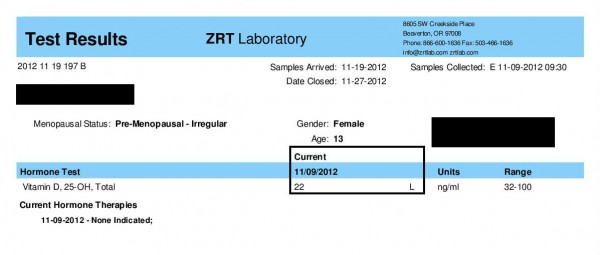
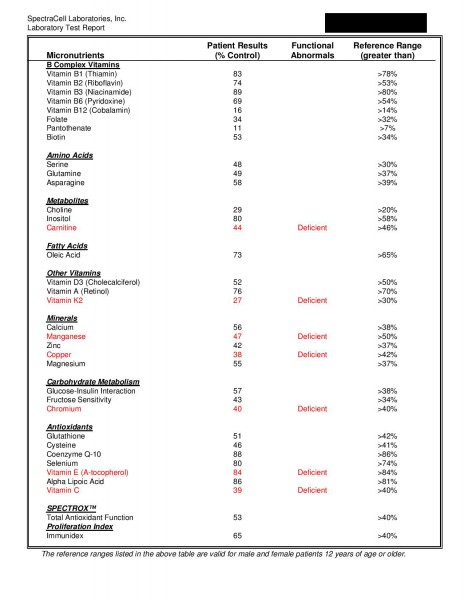
Magnesium
Along with calcium, magnesium is another mineral which is very important for bone health. Magnesium has numerous biological roles in our bodies (including helping with sleep). For bones, it is important for these reasons:
- Essential for absorbing and metabolizing calcium.
- Stimulates the thyroid to produce calcitonin, which preserves bones
- Regulates the parathyroid hormone, which in turn regulates bone breakdown
- Necessary for converting vitamin D into its active form
Calcium and magnesium have a symbiotic relationship. Magnesium helps regulate calcium levels. If you get too much calcium without enough magnesium, then the body will flush out magnesium. This is not something you want – especially considering 80% of magnesium is stored in our bones! It is thought that the best calcium-magnesium ratio is 2:1 or even 1:1, but most Americans get it in a 6:1 ratio. (Source 1)
Magnesium isn’t absorbed very well by the digestive system. So, one way to get more magnesium is to bypass the digestive system completely and absorb it through your skin. I do this by taking a magnesium bath (get a magnesium bath recipe here). You can also rub magnesium oil on your skin (I like this brand). If you do go with a magnesium supplement, I recommend this one.
Want more information about scoliosis? Download my eBook Treating Scoliosis to learn what causes it, how to manage it, and the best treatment options. You can buy it here.
Sign up to my VIP email list to hear about new posts as soon as they are ready. And, of course, I’d love to hear from you about your experiences with scoliosis in the comments below.
Latest posts by Sylvie McCracken (see all)
- Treating H. Pylori (Part 3): What H. Pylori Does to the Body - August 8, 2022
- Treating H. Pylori (Part 2): How H. Pylori is Contracted - August 3, 2022
- Understanding Beef Labels: Organic, Pastured, Grass-Fed & Grain-Finished - July 25, 2022
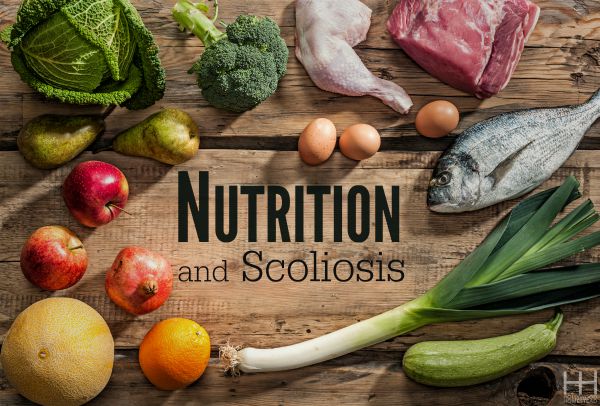

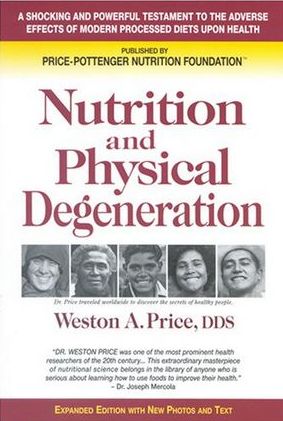
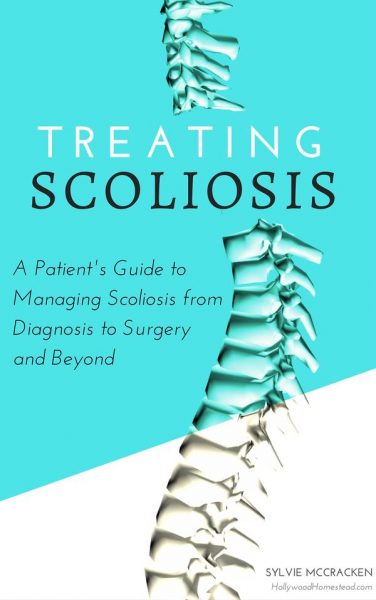
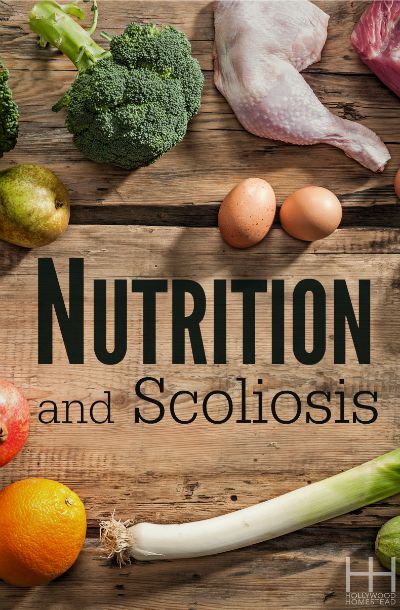
Hi! I love this page! I wish i had found this web before i had my spinal fusion ! I had my surgery 7 months ago and i am struggling with a lot of back pain! I would like to know how was your daughter recovery journey after de surgery, and i would also like to ask you for some tips, excercises, suplementation or anything you think that can help me. (my spinal fusion was from T2 to L2)
Magnesium chloride or magnesium oil is used for body massage. Pico ionic magnesium is taken orally. It is easilly absorbed.
Great job on discussing the epigenetic impact of nutrition on scoliosis. While scoliosis is often herriditary, how it is expressed is greatly affected by the epigenetic environmental factors such as nutrition. For more information on how epigentics influences scoliosis read this article – http://scoliosistreatmentalternatives.com/1437/epigenetics-in-scoliosis/
I especially love the fact that you promote getting the proper nutrients primarily from whole foods and then supplementing when needed. This is sound advice for parents with children with scoliosis. As you pointed out the best time to start a good nutritional program is before the onset of the curvature but no one thinks about that. For those parents it’s important that in addition to the nutritional piece they also start their child on a course of corrective therapy for their scoliosis as early as possible, as it is most correctable when the curves are still mild.
Yet there is a chance for prevention for parents who have a family history of scoliosis it would certainly be prudent to start their kids on a solid nutrition program before the onset of puberty as a percautionary measure.
Hi,
I find this article very interesting and informative! As for the magnesium, where on your skin do you rub it? And how often?
Thanks!
Hi Kayla,
You can rub it in the evening on the bottom of your feet.
Hope that helps,
Sylvie
I’m wondering if your daughter’s Vitamin D levels went up with the FCLO supplementation. I’ve heard some disturbing things lately about the fermented CLO, versus regular CLO, or other sources of Vit. D. Also, I’m confused why the Spectracell report showed Vitamin D3 as 52. But the first lab report as 22. Were these measuring different forms of Vitamin D?
Hi Sally,
Sorry I realize the date is cut off from the second test. That test was 13 months after the first. It’s difficult to say if it was the FCLO entirely. I suppose it could have also been the sun etc. I haven’t yet tried the regular CLO (although I’m well aware of the FCLO report) but I can tell you that I’ve never seen any negative effects from using the FCLO. Now that we’re living abroad getting a hold of either is rather complicated so it’s a decision that’s been postponed till we return.
Hope that helps!
Sylvie
I’ve been in the healing game nealy four decades, and what I found was a good diet was not enough. I found that Silica normalised the Calcium/Magnesium balance and itself was a major building block, as important as any amino acid! You can eat a great diet and supplement until you banish all negative symptoms, but until you realise the fundamental role Silica plays in life you won’t have the freedom of prolonged health. It’s level in agricultural soil today is 20% compared to the early 1900s when Silica levels were first tested! The (Scoli) exercises work when everything is available to the body, NEVER have surgery, unless it’s unavoidable. That’s my view of things, please understand some supplements are very effective and only need quarter dosing to avoid using up co-factors. Dosing advice on the bottle is based on laboratory/trial testing, go easy unless you know what you’re doing. Balance is the key.
Thanks for sharing your experience, Mark. I agree that surgery is a last resort.
So glad you’re all doing well now! Thanks for sharing your story. You can certainly share an excerpt and link to this article on your site if you’d like.
This is one of the best summations of nutrition for scoliosis that I’ve ever read. Great job! I came through the backdoor to find out I that I was deficient in all that you mentioned above, and I have scoliosis. A few years back my youngest son was very ill due to the S.A.D. and too many non-needed meds from doctors. Needless to say I took him off all meds, started GAPS and ended up paleo. Little did I know that I needed it as much as he did. We’re all doing great now and are as healthy as can be! The scoliosis world at large needs to read your awesome post. I have a company called Spiral Spine, which offers resources to the Scoliosis world. People living all around the world who have scoliosis contact me weekly to help them. I’d love to offer them this great article on nutirtion and scoliosis because all of it is true. Check out SpiralSpine.com and don’t hesitate to email via the contact page.
So glad you’re all doing well now! Thanks for sharing your story. You can certainly share an excerpt and link to this article on your site if you’d like.
Glad you found it helpful, Sarah! And I’m glad it will change your focus from now on. That’s all we can do- do better now that we know better. Hugs to you! Sylvie
Very interesting! I have severe scoliosis and had spinal fusion several years ago in my early 20’s. I have now just had my first child and have developed very painful joints (and they were never great to begin with). I’ll definitely be focusing on my nutrition from now on. Luckily, my daughter can benefit from a nutrient dense diet from the start so hopefully will not develop it.
Glad you found it helpful, Sarah! And I’m glad it will change your focus from now on. That’s all we can do- do better now that we know better. Hugs to you! Sylvie
Do you think you can reverse it? I have it and have low D. I am taking a supplement now.
Anna,
Stay tuned for the rest of the series. My daughter had to have surgery for it. No, I do not thing food will reverse scoliosis. Help? yes. Prevent? It’s a good possibility which we don’t yet have certainty of.
Regardless I think reversing micronutrients is a great first step.
Hope that helps!